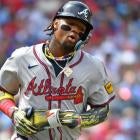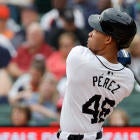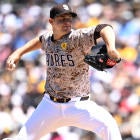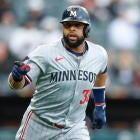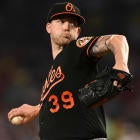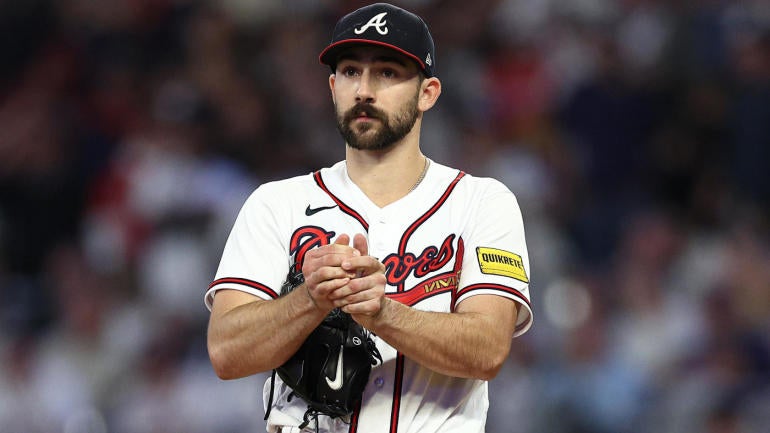
Injuries are a normal part of baseball. What we saw this weekend was not.
First came the news Thursday that Eury Perez would indeed need Tommy John surgery after the Marlins had already assured us there was no structural damage in his elbow, only inflammation. It was a gut punch that made me question the flow of information from team to reporter to general public, but Perez's elbow had been a subject of consternation for long enough that I could at least process the news.
Then came word Friday that Spencer Strider, the top pitcher in all of Fantasy, had left his start complaining of elbow soreness. There could be no preparing for that news. I feared the worst, and those fears were eventually confirmed by way of MRI. He has damage to his UCL, and while Tommy John surgery hasn't been prescribed yet, his season is likely over.
But in the hours leading up to that confirmation, as I was already deep into doomscrolling, came the third blow, a true blindside that would initiate my spiral into despair. Shane Bieber, an early candidate for Comeback Player of the Year after authoring two of the best starts of 2024 so far, was himself scheduled to undergo Tommy John surgery. No warning signs. No need for doomscrolling. He was simply done.
So to recap, we lost the most exciting sophomore pitcher (Perez), the most exciting bounce-back pitcher (Bieber) and the most exciting pitcher period (Strider), all to the same basic injury and all in the span of three days.
It was a rough weekend, to be sure. It was also the second weekend of the season, so it's not like we can say, "wow, bummer, but at least we know what we're working with now." We have no clue what we're working with because we've barely stepped through the door.
And already, the starting pitcher landscape looks entirely different from what we were promised. You may remember there was a brutal string of injuries in the run up to the season as well. Gerrit Cole, who was originally being drafted alongside Strider in Round 1, is down for several more weeks with an elbow injury that doesn't seem so serious, but then again, neither did Perez's. Meanwhile, Kyle Bradish's season still hangs in the balance because of his own UCL problem. There's also Kodai Senga's shoulder injury, Justin Verlander's shoulder injury, Justin Steele's hamstring injury and on and on as you make your way down the starting pitcher rankings.
It all makes for a feeling of "who's next?" -- because there will be a next, even though we've already lost so much.
If I sound depressed, it's because I am. I'm not even that invested in Strider, Bieber and Perez, having a combined three shares of them across all of my leagues, but the idea, particular in Strider's case, of designing a whole team around a player only for that team never to get off the ground is about as tragic as it gets in Fantasy Baseball. So much planning goes into something so easily exploded. And yes, injuries are a normal part of baseball, but this many injuries to such critical pieces so early in the season is enough to trigger your most nihilistic impulses. There are no good or bad picks, only pain.
Alas, my job isn't to wallow in misery but, rather, to analyze, and so analyze I will by responding to three of the questions being raised most often on social media.
Why is this happening?
It's the topic most widely debated in light of this weekend's injuries, and the best answer is probably that there is no one answer. Multiple theories were bandied about, though, all backed up by some person of note.
Let's begin with Strider's own theory, which he voiced about a month prior to his injury, having to do with the pitch clock:
"The league is making rule changes despite an injury epidemic that could very well be encouraging injuries, such as the pitch clock, limiting the number of pitchers on roster, how many pitching changes you can make, how many mound visits you can have – all those things are making pitching harder and potentially, I think, making health more difficult to manage," Strider said. "With injury rates where they are, I don't know how we can blindly decrease the clock after the worst injury season in baseball, arguably, without having a conversation about injuries."
Certainly, the pitch clock is one of the newest and most visible changes, and, as Strider pointed out, it was made two seconds shorter with runners on base this year. But the causal link between the pitch clock and pitching injuries, while perhaps intuitive, is only circumstantial. For what it's worth, MLB cites an independent study from John Hopkins University that reveals no connection between the two.
Strider referenced other rule changes, though, and while he didn't cite it directly, I often think back to the sticky substance crackdown that happened midway through 2021 -- or more specifically, what Tyler Glasnow had to say about it.
"If you felt these balls, how inconsistent they were, you have to use something," he said. "Your favorite pitcher 50 years ago was probably using something, too"
It wasn't just excuse-making for Glasnow, who revealed that he had always used a combination of sunscreen and rosin. Eliminating them required him to grip the ball tighter and further down his fingers, altering his release and adding tension to every throw. It worked well enough in his first outing June 8 of that year against the Nationals, but he paid for it in his very next start.
"I woke up the next day and was like, I am sore in places that I didn't even know I had muscles. I felt completely different," he said. "And then that same feeling is persisting all week long. I go into my start [June 14] and that same feeling, it pops, or whatever the hell happened to my elbow."
What happened was he tore his UCL, an injury that would sideline him for more than a full calendar year.
"I [had] to change everything [I was] doing," he said. "I'm telling you, I truly believe that's why I got hurt."
Personally, I find Glasnow's explanation to be the most cohesive, and the timeline correlates closely to the introduction of the pitch clock. There's also the anecdotal evidence of pitchers with no injury history coming over from Japan, where a tacky baseball is used for better grip, and soon becoming just as injury-prone as anyone else.
Of course, it may simply be that pitchers are asking more of their arms these days, throwing higher-stress pitches at even higher velocities. Ken Rosenthal and Eno Sarris teamed up on an article addressing this issue back in March, specifically citing one team physician's discomfort with the advent of the sweeper and power changeup.
"We're seeing all these tears in the lat and teres, all these tears of the previously reconstructed ligament, a lot more flexor-tendon tears," said Dr. Keith Meister of the Rangers, who pioneered the internal brace procedure. "I can tell you it is a consequence of predominantly those two pitches — the sweeping slider and these hard movement changeups."
It's worth pointing out that the increased prevalence of pitcher injuries has been a topic of discussion for a couple decades now, and that we're no closer to a solution would suggest that the league isn't particularly interested in one. But perhaps this latest rash is the tipping point. Certainly, it's at the center of attention right now, and the players union is voicing its discontent. The sweeper probably isn't going anywhere, but could amendments to the pitch clock and/or further experimentation with a tacky baseball (which got some use in the minors last year) be in the offing?
Should we have seen it coming?
There was no shortage of wise guys taking a devilish sort of victory lap over this weekend's developments, particularly with regard to Strider. Their claim was twofold:
- Everyone should know better than to take a pitcher early.
- Anyone could see this injury coming given how hard Strider throws.
On the first point, I mostly agree. In fact, my preferred strategy for this year was to wait until Round 4 to draft a pitcher and then to take more than I thought I'd need on account of the position's volatility, with injury risk being a part of that. And of course, the idea that hitters are safer investments than pitchers is longstanding Fantasy doctrine.
But there's something to be said for taking a bigger risk, particularly in the 15-team Rotisserie leagues that have become the favorite of the expert class. The draft takes on greater significance when there's little waiver wire to speak of, which ramps up the pressure to hit a home run with it. Strider was clearly the top-ranked starting pitcher, projecting for far and away the most strikeouts while having the ability to dominate the other pitching categories as well. At a volatile time for pitching in general, one might argue that the potential rewards were significant enough to justify the added risk. I never found occasion to draft Strider this season, but I at least considered it in those deeper formats.
As for the second point, while elbow problems are inherent to the entire pitching profession, I wouldn't have singled out Strider as uniquely suited for them. In fact, I'd have come closer to saying the opposite. It's true he had Tommy John surgery in college, but that's when he remade himself into the pitcher we know now, emphasizing the extension of his lower body for more power and a better approach angle. You ever wonder why his quads are so big? That's where all his power comes from. His delivery is all in his legs, which theoretically reduces the strain on his arm. You could say he had some of the best mechanics for avoiding a serious injury, but alas, one found him anyway.
The I-told-you-so crowd was beating its chest over Bieber as well, making two claims with regard to him:
- He had a forearm injury last year, duh.
- Again, everyone should know better than to take a pitcher early.
On the first point, it's indeed true that Bieber missed 2 1/2 months with a forearm strain, and forearm issues are often a precursor to elbow issues. But strains generally heal on their own, and we had every reason to believe that Bieber's had. For one thing, he came back for two starts at the end of last season. For another, he spent a big part of the offseason working with Driveline Baseball to improve his velocity and secondary offerings.
Pitchers who are hurting generally don't partake in extracurricular throwing, certainly not of an experimental variety. And before you blame Bieber's decision to work with Driveline Baseball, note that it's the only reason we were back on board with him in the first place.
As for the second point, Bieber was being drafted in Round 10, on average, in 12-team leagues. As much as it may pain you to take a starting pitcher ever, you do still need to compete in the pitching categories. There are endless ways to build a competitive pitching staff, but almost all of them involve drafting a pitcher at some point, usually prior to Round 10. And in a league of any depth, it's unrealistic to think you're going to pull off the inside straight required for a stable ERA and WHIP without the security of a high-end arm or two. Even taking Bieber as your third starting pitcher would have probably been underdoing it.
Mostly, what I'm trying to say here is that these injuries aren't as easy to predict as some are claiming, and I can't help but notice that those trumpeting their brilliance now weren't nearly so loud two weeks ago. If they think their pitching staff will remain unscathed all year, they're in for a rude awakening.
What should we do moving forward?
If you're looking for replacements, Chris Towers has you covered in the latest edition of Waiver Wire. I'll just say that in shallower leagues -- say, fewer than 300 players rostered -- there are more quality pitchers than available spots, in all likelihood. It won't stay that way, of course. Some of those emerging names will fizzle out, and as we've already covered, other pitchers will get hurt. But you have some recourse. One advantage shallow leagues have over deep leagues is the ability to navigate a major injury loss.
What's more interesting to consider than the here and now is whether the way we draft pitchers should change in response to the carnage we're seeing now. Of course, it's too early to commit to anything. Maybe the pace of injuries will slow to the point that this season no longer seems like an outlier. It's a fanciful idea, but not altogether implausible.
Otherwise, I think we just have to plan to overdraft pitching, specifically in terms of quantity rather than quality. The "pocket aces" strategy that many have championed in recent years might be too dangerous, both because of the early investment it requires and the lack of depth it provides. I don't think I was so far off with my approach this year of taking mostly pitchers between Rounds 4 and 10, and if it becomes trendy enough, then a higher caliber of pitcher will be available in that range.
Of course, it's easy to talk a big game now, but when the slate is wiped clean and the previous season becomes a hazy memory, many will be so naive as to presume the best-case scenario for the best pitchers on the board again. Maybe just make sure not to be among them.
















